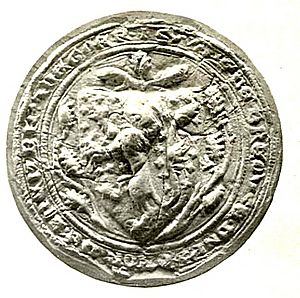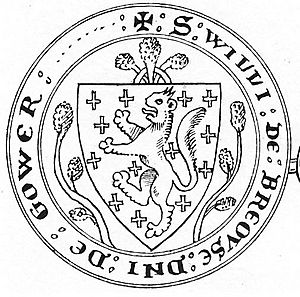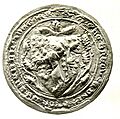William de Braose, 2nd Baron Braose facts for kids
Quick facts for kids
William de Braose
|
|
|---|---|
| Baron Braose, Lord of Bramber, Lord of Gower | |

Seal of William de Braose, 2nd Baron Braose, showing his family's coat of arms.
|
|
| Born | c. 1260 |
| Died | 1326 |
| Noble family | House of Braose |
| Spouse(s) | Agnes (family name unknown); Elizabeth de Sully, daughter of Raymund de Sully |
| Issue | Aline de Braose, Joan de Braose, William de Braose |
| Father | William de Braose, 1st Baron Braose |
| Mother | Aline, daughter of Thomas de Multon |
| Occupation | Nobleman |
William de Braose (born around 1260–1326) was an important nobleman in medieval England. He was the second Baron Braose, and also held the titles of Lord of Gower and Lord of Bramber. These titles meant he controlled large areas of land.
When he was a child, William was held as a hostage in 1264 during a conflict called the Second Barons' War. Records show details about his childhood expenses while he was a hostage. He began working for the king in 1286. In 1291, he took over his father's titles and lands. He continued to serve the king in military campaigns in Scotland and Wales. William spent much of his life dealing with arguments over his lands. These disputes later helped cause a rebellion against King Edward II of England and his close advisors, the Despensers. William de Braose married twice. His main heirs were his daughter Aline and his grandson John de Bohun.
William's Family and Early Life
William de Braose was the son of William de Braose, 1st Baron Braose. His mother was Aline, who was the daughter of Thomas de Multon. He was probably born around 1260. We know he was born before 1264 because he was captured that year.
Captured During the Barons' War
This capture happened during the Second Barons' War (1264–1267). This war took place when King Henry III of England was on the throne. William's father had supported the king against a rebellion led by Simon de Montfort. Young William was held as a hostage by Montfort's wife, Eleanor. Her household records show the costs of caring for William during this time.
Serving the King
Around 1285, William de Braose confirmed land gifts made by his ancestors to a religious house called Sele Priory. In 1286, William began working for King Edward I. He might have traveled with the king to Paris. There, King Edward showed his loyalty to the new French king, Philip IV, for Edward's lands in France.
William played a big part in King Edward's wars in Wales. In the winter of 1287–1288, he led the forces that surrounded Emlyn castle. His soldiers also helped move a huge siege engine from Dryslwyn to Emlyn. This machine, along with 480 large stones, convinced the castle's defenders to give up peacefully.
Becoming a Marcher Baron
William de Braose became the leader of his family's lands before March 1, 1291. On that day, he officially showed his loyalty for his father's lands. He was given control of these lands on March 2, 1291. From 1291 until 1322, he was called to Parliament many times as Baron Braose. He was the second person to hold the title of Baron Braose. He was also the Lord of Gower and Lord of Bramber.
Military Service and Important Letters
After his father passed away, William continued to serve King Edward I. He gave both money and his own military service to Edward's wars. These wars were fought in Wales, Scotland, and France. In 1294, he served in Gascony, France. In 1297, he took part in a military campaign in Flanders. As a reward for his service, he was given the care of John de Mowbray. William later arranged for John de Mowbray to marry his daughter, Aline.
From 1298 to 1306, William was involved in the wars against Scotland. He was present at the Battle of Falkirk on July 22, 1298. Besides fighting, he also served the king in 1301. He signed a letter from the most important barons of England to Pope Boniface VIII. In this letter, the barons complained about the Pope interfering with the king's rights in England.
The Story of William Cragh
In 1290, William de Braose captured a Welsh rebel named William Cragh. There was a famous story that Cragh miraculously came back to life after being put to death. This miracle was believed to be due to Thomas de Cantilupe. Because of this, in 1307, William de Braose gave his testimony to church officials. They were investigating the events around Cragh's death to see if it would help make Cantilupe a saint.
Disputes Over Land
William de Braose was often involved in arguments over his lands. In 1299, the Bishop of Llandaff, John de Monmouth, brought a case against Braose about his lordship of Gower. Although a decision was made in 1302, it was later changed. In 1304, Braose got King Edward to confirm his special rights in Gower. He was able to do this because he was serving the king in Scotland at the time, which gave him easy access to the king.
However, in 1305, Braose made a mistake. He insulted a royal judge using very rude words. This caused the Gower case to be reopened in 1306. Braose could only solve the problem by giving certain rights to his men in Swansea and Gower.
The Gower Dispute and the Despensers
In 1320, King Edward II of England took control of the lordship of Gower. The king said Braose had given it to his son-in-law, Mowbray, without royal permission. Before this, Braose had promised Gower to several people, including Humphrey de Bohun, Hugh Despenser the Younger, and Roger Mortimer.
Mowbray took control of Gower in late 1319 to protect his rights. However, Despenser convinced the king to take Gower in October 1320. Despenser was then put in charge of the area in November. Other lords in the Welsh Marches were angry about this. They felt the king's reason for taking the land was not fair. This seizure was one of the main reasons for a rebellion by the barons. This rebellion led to the exile of the Despensers in 1321.
In 1322, Gower was given to the younger Despenser again. He then traded it for other lands called Usk and Caerleon. Braose was then encouraged to sue the new owner of Gower to get the land back in April 1324. He won the case in June 1324. Braose then quickly gave Gower to the elder Despenser. This meant the property went back to the Despenser family. The lordship of Gower eventually ended up with the Beauchamp family, but this was not decided until the 1350s.
Marriage, Death, and Legacy
William de Braose's first wife was named Agnes, but her family is not known. His second wife was Elizabeth, the daughter of Raymund de Sully. He had two daughters with his first wife. He did not have any children with his second wife, who lived longer than him.
It seems he had a son named William. This son was called to military service by King Edward in 1311. However, nothing more is mentioned about him after 1315. In 1316, when William the father's estates were arranged, there was no mention of this son. This suggests the son likely died before that date.
William de Braose died shortly before May 1, 1326. His main heirs were his daughter Aline and his grandson John de Bohun. Aline, the older daughter, married John de Mowbray, 2nd Baron Mowbray and later Richard de Peschale. His second daughter, Joan, married James de Bohun and then Richard Foliot. Mowbray received the lands of Gower and Bramber before William de Braose's death.
William de Braose was known for often being in debt. He was also said to have trouble managing his money. A writer named Thomas Walsingham wrote that Braose was "very rich by birth but wasted the property left to him."
Images for kids




